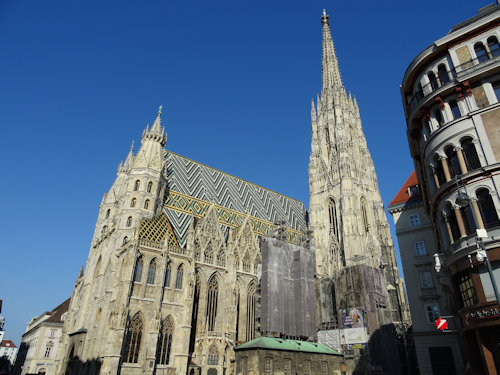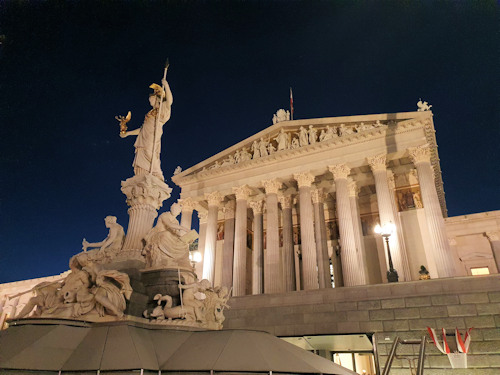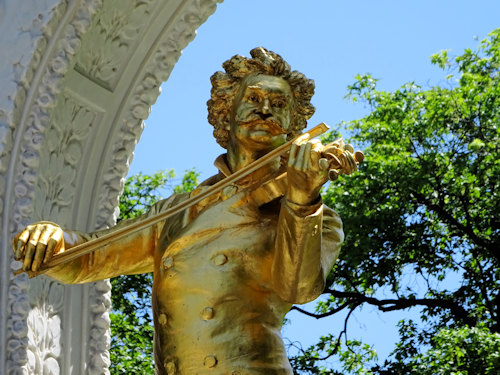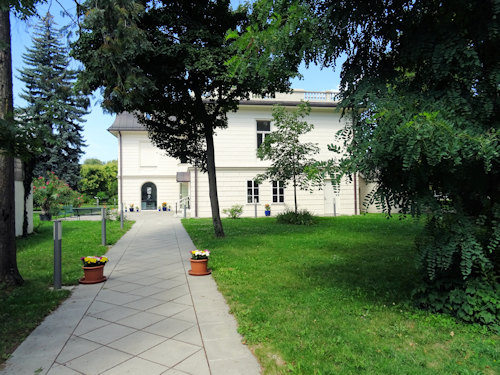
Enjoy a selection of ways to tour Vienna on foot, including self-guided and guided alternatives, along with suggestions for some themed options.
- Book a guided tour* from a central hub
- See also:
- Tours overview for Vienna
- Hop on hop off buses
Jump to:
- Self-guided walk around the centre
- Guided tours
- Themed tours
- History & architecture
- Eras & historical locations
- Music and art
- Composers, artists & architects
- History & architecture
- All-Inclusive Pass
Self-guided walk

(You start at the State Opera House…)
Many of the historical sights in Vienna live in the compact, largely flat, and eminently walkable city centre.
I’ve put together a set of suggestions for seeing the important locations on your own with photos, instructions, visitor tips, and links to more information on what you pass.
Wander the old town at your leisure (or take a total of around 90 minutes if you don’t hang around):
- Part 1: you begin at the Staatsoper and walk to the edge of the Habsburg’s Hofburg palace complex
- Part 2: historical Michaelerplatz square and through the Hofburg to Heldenplatz square
- Part 3: along a stretch of the old town city limits flanked by many of Vienna’s most famous buildings
- Part 4: back through the pedestrianised centre to end at Stephansdom cathedral

(…and end at the cathedral)
If you prefer a more rural wander around the city, Vienna has numerous formal and clearly-marked hiking routes. Most take you into the surrounding woods and hills, with a couple of notable exceptions (like the social housing walk).
Guided tours
Since Vienna has dozens of certified tour guides willing to take you on all sorts of trips, I would simply send you to three other websites:
- City tours*: various scheduled tours in Vienna for direct online booking. Many on foot, but also bus & bike tours
- Findaguide.at: the Chamber of Commerce directory of guides you can hire
- Guides-in-vienna.at: directory of the Association of Licensed Guides in Vienna
With few exceptions, working as a tour guide in Vienna needs a state license (awarded after completing a lengthy training & education programme and then passing an exam).
A strong alternative to a general guided walking tour is, of course, one of the hop on hop off bus services.
Themed tours
Aside from any specialist tours provided by the above, I have a few articles and links for those looking to explore particular themes. We begin with…
History & architecture
Many locations offer their own specialist in-house tours, notably the two Habsburg palace complexes, the cathedral, the Spanish Riding school, and traditional music venues like the State Opera House or Musikverein.
Architectural epochs

(The refurbished parliament building, constructed in the Hellenic style)
Within the following introductions to architectural and design eras relevant to Vienna, you’ll find tips on where to see examples.
- Baroque: an ostentatious style from the 1600s and early 1700s. Several of Vienna’s more popular palaces and churches date back to this period.
- Biedermeier: a more conservative, homely approach that developed in the first half of the 19th century as a consequence of what we’d probably call a police state today.
- Historicism: where architects and designers drew inspiration from the past. Particularly popular in the second half of the 1800s, which explains all the neogothic, neorenaissance and similar buildings from that time.
- Jugendstil: Vienna’s Art Nouveau movement whose heyday was the late 1800s and early 1900s. The pedestrianised centre has notable architectural examples, as does the rest of the old town.
Other themed historical location tips

(The Sisi memorial in the Volksgarten park)
- Empress Elisabeth: explore those sights closely associated with the famous Sisi, including her apartments and a dedicated museum
- Vienna Modernism: Vienna’s creative flame probably burned brightest around 1900 (though my current calender and to-do list are a remarkable experiment in modernist creativity).
- Jewish Vienna: the article covers significant locations.
- Social housing: experts consider Vienna a role model for urban development, thanks in large part to the availability of high-quality city-owned housing. This harks back to the remarkably farsighted social housing projects of post-WWI, whose legacy remains in the cityscape.
Music and art
As mentioned above, major concert venues have in-house tours. I can particularly recommend the tour of the Staatsoper. Quite apart from the gorgeous interiors, the guide has enough anecdotes to fill a 5-hour Wagner opera.
Composers

(The golden Strauss monument)
A musician-themed walking tour is very easy. Just stand anywhere in the older parts of Vienna and look around. Chances are you’re next to where some baton-wielding giant of classical music lived / died / composed / played (not necessarily in that order).
But for detailed tips on places to see, I have a famous footsteps page that lists locations for Mozart, Beethoven, Strauss (II), Haydn, Schubert, Brahms, Mahler, Liszt, Lehár and Bruckner.
Most of the composer guides split into three sections: life locations (residences and similar), music locations (venues for premieres and similar), and memorials & more (monuments, museums and similar).
Artists & architects

(Gustav Klimt’s final studio)
That same On the trail of… page also has location guides for the artists Gustav Klimt and Egon Schiele, the artist/architect Friedensreich Hundertwasser, and the architect Otto Wagner.
All the guides cover places to see their works (or buildings in the case of Wagner and Hundertwasser) and those places associated with their life and legacy.
Vienna All-Inclusive Pass
As a final tip, the Vienna All-Inclusive Pass from Go City is the tourist pass with the greatest focus on tours and activities. At the time of writing, for example, it included one-time free access to 10+ walking, bike and bus tours.